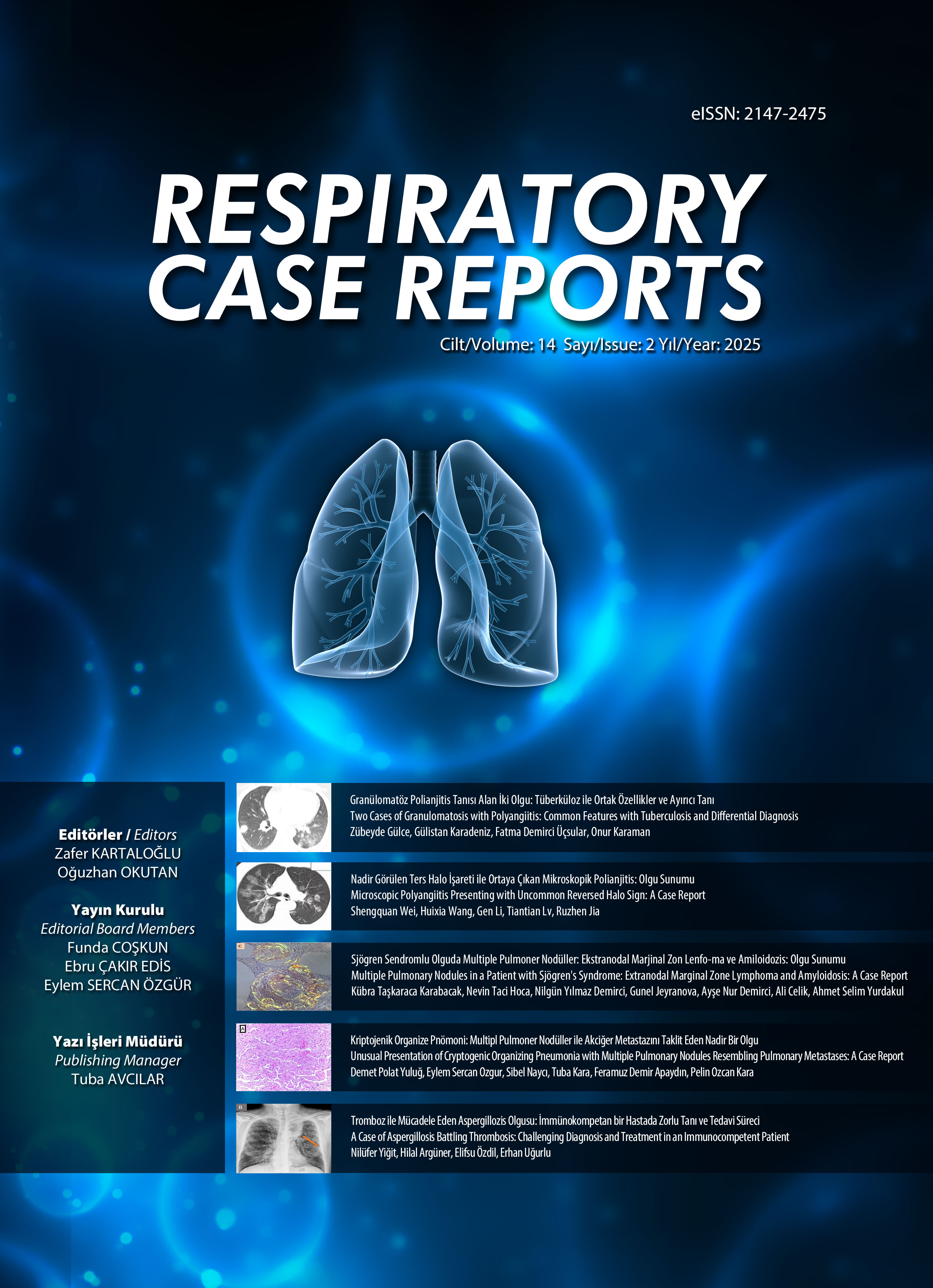e-ISSN 2147-2475

Volume: 11 Issue: 1 - February 2022
| CASE REPORT | |
| 1. | Post Intensive Care Tele Pulmonary Rehabilitation in Post-COVID-19: A Case Series Mustafa Engin Şahin, Seher Satar, Pınar Ergün doi: 10.5505/respircase.2022.92195 Pages 1 - 8 Muscle weakness acquired in intensive care, post-intensive care syndrome, psychological dysfunction and changes in body composition are the main rea-sons cited in Pulmonary Rehabilitation (PR) applica-tions after discharge in cases followed up in the in-tensive care unit (ICU) due to COVID-19 pneumonia. Although the limitations of face-to-face PR applica-tions during the pandemic have made tele-PR more common, the appropriate patient profile for PR is still unknown. In this case series, video conferencing-mediated tele-PR was applied as a hybrid approach and compared with PR in a face-to-face format in five cases referred after ICU. After the initial and final evaluations and the first two exercise sessions were performed in the outpatient PR unit, the program was continued via a video-conferencing method. At the end of the total 18 sessions, a decrease was noted in the perception of dyspnea, and an increase in exer-cise capacity and muscle strength. A decrease in the severity of COVID-19-related fatigue was also noted. |
| 2. | Diabetes Insipidus in Severe COVID-19 Pneumonia Özge Pekşen, Kezban Özmen Süner, Halil Kızılışık, Havva Kocayiğit, Ali Fuat Erdem doi: 10.5505/respircase.2022.30316 Pages 9 - 12 Coronavirus disease 2019 (COVID-19) usual-ly presents as a respiratory infection, and may progress to multiple organ failure and eventually death. In COVID-19 patients, kid-ney dysfunctions reported proteinuria, ele-vated markers of blood urea nitrogen, plasma creatinine, uric acids, and D-dimer. We present here the case of a 49-year-old male who was admitted to the intensive care unit (ICU) with COVID-19 pneumonia and respiratory failure. Diabetes insipidus (DI) developed during intensive care follow-up without electrolyte imbalance or kidney failure. A contrast-enhanced brain and pitu-itary MRI was performed to identify the eti-ology of the central DI, but revealed no pathological findings. The drugs used to treat our patient had no polyuria side ef-fects. No electrolyte imbalance was identi-fied from a blood test of our patient, and there were no findings of other diseases in the differential diagnosis that could lead to nephrogenic DI. We present here a case of COVID-19 infection complicated by nephrogenic diabetes insipidus, given the lack of reports in literature indicating the occurrence of diabetes insipidus alongside COVID-19 infection. |
| 3. | Cavitary Pulmonary Lesion Due To COVID-19 Infection Mimicking Lung Cancer Seher Satar, Mustafa Engin Sahin, Pinar Ergun doi: 10.5505/respircase.2022.35403 Pages 13 - 18 Various radiological findings have been detected associated with SARS-CoV-2 (COVID-19). We pre-sent here a middle-aged patient with a thick-walled cavitary lesion resembling lung cancer radiologically after COVID-19. Most of the etiological factors for cavitary lung lesions were investigated, and no specif-ic cause was found. After empirical dual antibiotic treatment, the cavitary and the nodular lesion were observed to regress almost completely in control thorax computed tomography. For this reason, we considered the cavity of our patient as a late compli-cation of COVID-19 and also we advocate the im-portance of monitoring patients with clinical data and laboratory values as well as radiological findings after contracting COVID-19. |
| 4. | Delayed Pulmonary Embolism after Mild COVID-19: A Case Report Fatma Tokgöz Akyıl, Seda Tural Onur, Kübra Gül Kılınçarslan, Kaan Kara, Mustafa Vedat Doğru, Nurdan Şimşek Veske, Melih Akay Arslan doi: 10.5505/respircase.2022.42744 Pages 19 - 24 COVID-19 coagulopathy has gained attention due to the strikingly high prevalence of deep vein thrombosis (DVT) and pulmonary embolism (PE). We describe here a case of bilateral PE preceded by mild COVID-19 contracted 4.5 months earlier in a male patient who presented to the outpatient clinic with exertional dyspnea. The patient had developed PE 9 years earlier, when no underlying genetic factor was detected. In the 4.5 months after contracting mild COVID-19, he presented four times with exertional dyspnea and a thorax computer tomography angiography (CTA) on two occasions and one perfusion scintigraphy revealed no embolism. Based on his high D-dimer values, his symptoms and his history of PE, he was placed on prolonged PE prophylaxis, which was stopped 33 days ago, and at that time, CTA revealed extensive bilateral PE. In conclusion, an unusually longer activation in COVID-19 coagulopathy may co-exist in patients with a history of previous PE, ongoing symptoms and increased D-dimer levels, irrespective of the COVID-19 severity. |
| 5. | COVID-19 and Renal Artery Thrombosis: A Case Report Recai Ergün, Dilek Ergün, Hacer Sürer Shalabi, Mahmoud Yousef Shalabi, Fikret Kanat, Baykal Tulek, Burcu Yormaz, Alaaddin Nayman doi: 10.5505/respircase.2022.40374 Pages 25 - 29 Since the onset of the COVID-19 pandemic, there is increasing evidence that infected patients exhibit a high incidence of thrombotic complications. Although respiratory symptoms are dominant in COVID-19, those with the condition may have extrapulmonary involvement. |
| 6. | Transition from Oral Selexipag to Subcutaneous Treprostinil in a Patient with Idiopathic Pulmonary Arterial Hypertension: An Eight-Day Protocol Wan-jing Ho, Chia-pin Lin, Lung-An Hsu, Chun-li Wang doi: 10.5505/respircase.2022.55476 Pages 30 - 35 Pulmonary arterial hypertension (PAH) is a progressive and debilitating disorder. Specific medications target the nitric oxide, endothelin and prostacyclin pathways. Oral medications are usually administered in low-risk patients, while parenteral prostanoids are recommended for those at high risk, especially those with a WHO functional class of IV or those in whom the therapeutic goals of oral medications were not achieved. Selexipag is a selective prostacyclin (PGI2) receptor (IP receptor) agonist, while Treprostinil is a prostacyclin analog. There are no standard guidelines directing the transition from oral selexipag to subcutaneous (SC) treprostinil. We describe here a successful approach to this transition in a patient with idiopathic PAH, proposing an 8-day protocol that may serve as a useful guide in clinical practice. The estimated equivalent doses of oral selexipag to SC treprostinil is 200 µg twice daily = 5 ng/kg/min. Following the transition, the patient experienced improvements in symptoms, serum B-type natriuretic peptide levels, oxygen saturation and echocardiographic parameters. |
| 7. | A Case of Pulmonary Alveolar Proteinosis in which a New Approach to the Traditional Whole Lung Lavage Technique is Preformed Göksel Altınışık, Nilüfer Yiğit, Beste Metin, Merve Türkarslan, İlknur Hatice Akbudak doi: 10.5505/respircase.2022.98470 Pages 36 - 40 Pulmonary alveolar proteinosis is a rare interstitial lung disease that is characterized by an accumulation of surfactant composed of proteins and lipids in the alveoli. Whole Lung Lavage (WLL) protocols, which have been used for more than half a century and are still considered the optimum approach, vary according to centers, and there is no standard lavage technique. In this case report we describe a method that does not require technology in which the patient's chest is vibrated with strong and rhythmic movements, using it instead of the manual vibration method used in our WLL applications for the mechanical washing of the alveolar space. In this case report, we also draw attention to the fact that intensive care hospitalization can be prevented by CPAP treatment in the recovery room before hypoxemia deepens. In conclusion, our case report shows that more lung areas can be included in the lavage through the addition of the easily accessible and applicable vibration method that we describe to the WLL technique. The study also reports on our observations that CPAP support applied during postoperative recovery can reduce the hospitalization of patients in intensive care after WLL. |
| 8. | An Interesting Case of Adenocarcinoma: Miliary Metastases Canatan Taşdemir, Yusuf Aydemir doi: 10.5505/respircase.2022.01488 Pages 41 - 43 Diffuse miliary lesions in the lungs are mostly observed in tuberculosis, sarcoidosis and pneumoconiosis, while hematogenous metastases of some cancers of the lung may rarely have a miliary appearance. We present here a case of primary lung adenocarcinoma with miliary lesions and diagnosed by bronchoscopy. |
| 9. | Rare Interstitial Pneumonia Due to the Use of Aripiprazol: A Case Report Gülistan Alpagat, Ayşe Baccıoğlu, Sümeyra Alan Yalım, Merve Poyraz, Betül Dumanoğu, Ayşe Füsun Kalpaklıoğlu doi: 10.5505/respircase.2022.80948 Pages 44 - 49 It is accepted that 23% of interstitial lung diseases (ILD) are due to drugs, and that 70% of drug-induced lung diseases are due to ILD. We present here the case of a 51-year-old female patient who had been taking aripiprazole for bipolar disorder for 3 years and had been undergoing asthma treatment for 2 years. ILD was considered based on the patient's clinic, a restrictive pattern in the pulmonary function test (PFT), a decreased carbon monoxide diffusion test, laboratory results, radiological findings and biopsy. The possible etiologies of infection, aspiration, heart failure, pet feeding status and exposure to hazardous respiratory substances were excluded. The suspected drug was discontinued and oral corticosteroid treatment was started. Lung toxicity can develop with drug treatments, and so drug history should be questioned in detail and discontinued immediately in case of any doubt. ILD is rare, and if the drug is not suspected and continued, the disease may become chronic and progress to respiratory failure. We present this case to increase awareness of the disease. |
| 10. | Williams-Campbell Syndrome Diagnosed in Adulthood: A Rare Entity of Bronchiectasis Kübra Gül Kılınçarslan, Fatma Tokgöz Akyıl, Neslihan Boyracı, Metin Sucu, Melih Akay Arslan, Hülya Abalı, Kaan Kara, Seda Tural Önür doi: 10.5505/respircase.2022.94546 Pages 50 - 54 Williams-Campbell syndrome is a rare condition caused by a deficiency or complete absence of bronchial wall cartilage formation, resulting in distal airway collapse and bronchiectasis. The syndrome, generally encountered first during infancy, progresses with recurrent pneumonia with such obstructive symptoms as cough and wheezing from childhood onwards, while adult cases are rarely reported. A 40-year-old male patient presented with complaints of shortness of breath, cough and fever for one week. He was hospitalized with a diagnosis of bronchiectasis exacerbation due to elevated infection parameters, when radiology revealed extensive cystic bronchiectasis, air trapping and airway collapse at expiration. After excluding other etiologies, the patient was diagnosed with Williams-Campbell syndrome in light of the clinical and radiologic findings. He was discharged following clinical response and started on a pulmonary rehabilitation program, was referred to a lung transplantation clinic. The case is representative of the set of rare adult cases showing that Williams-Campbell syndrome can be diagnosed in adulthood, and signaling that the etiology of bronchiectasis should be further evaluated in advanced ages. |











